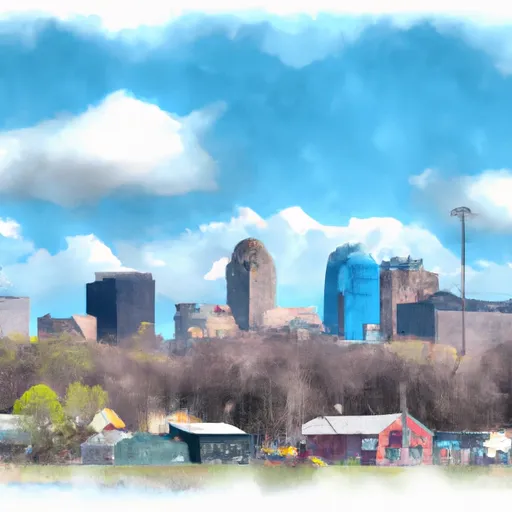-
 Snoflo Premium
Snoflo Premium
Get unlimited access to all our content
With no Ad interruptions! - Start Your Free Trial Login with existing account
New-London
Eden Index
Climate
6.3
•
Recreation
1.7
•
Community
1.1
•
Safeguard
3.4/10

New London is a small city located in central Minnesota, known for its picturesque landscapes and outdoor recreational opportunities. The climate in New London is characterized by cold winters and warm summers. The hydrology constituents of the area include several lakes, with Green Lake being the largest and most popular for fishing, boating, and swimming. Other lakes in the vicinity offer similar opportunities. Outdoor enthusiasts can also explore the surrounding natural areas, such as Sibley State Park, which offers hiking trails, camping sites, and wildlife viewing. In addition, the Glacial Lakes State Trail is a popular destination for biking and walking, providing breathtaking views of the surrounding countryside. With its diverse hydrology constituents and beautiful natural surroundings, New London offers a wide range of outdoor activities for visitors and residents to enjoy.
What is the Eden Index?
The Snoflo Eden Index serves as a comprehensive rating system for regions, evaluating their desirability through a holistic assessment of climate health, outdoor recreation opportunities, and natural disaster risk, acknowledging the profound impact of these factors on livability and well-being.
Climate Health Indicator (CHI): 6.3
New-London receives approximately
749mm of rain per year,
with humidity levels near 84%
and air temperatures averaging around
7°C.
New-London has a plant hardyness factor of
4, meaning
plants and agriculture in this region thrive during a short period during spring and early summer. Most
plants will die off during the colder winter months.
By considering the ideal temperature range, reliable water supplies, clean air, and stable seasonal rain or snowpacks, the Climate Health Indicator (CHI) underscores the significance of a healthy climate as the foundation for quality living.
A healthy climate is paramount for ensuring a high quality of life and livability in a region, fostering both physical well-being and environmental harmony. This can be characterized by ideal temperatures, reliable access to water supplies, clean air, and consistent seasonal rain or snowpacks.
Weather Forecast
Streamflow Conditions
Upper Mississippi-Crow-Rum
Area Rivers
Upper Mississippi-Crow-Rum
Snowpack Depths
Upper Mississippi-Crow-Rum
Reservoir Storage Capacity
Upper Mississippi-Crow-Rum
Groundwater Levels
Recreational Opportunity Index (ROI): 1.7
The Recreational Opportunity Index (ROI) recognizes the value of outdoor recreational options, such as parks, hiking trails, camping sites, and fishing spots, while acknowledging that climate plays a pivotal role in ensuring the comfort and consistency of these experiences.
Access to outdoor recreational opportunities, encompassing activities such as parks, hiking, camping, and fishing, is crucial for overall well-being, and the climate plays a pivotal role in enabling and enhancing these experiences, ensuring that individuals can engage in nature-based activities comfortably and consistently.
Camping Areas
| Campground | Campsites | Reservations | Toilets | Showers | Elevation |
|---|---|---|---|---|---|
| Frames Landing Campsite | None | 1,326 ft | |||
| Mantrap Lake - Paul Bunyan State Forest | 38 | 1,531 ft | |||
| Memorial Forest Park - Menahga | 24 | 1,396 ft | |||
| Huntersville Township | None | 1,378 ft | |||
| Knob Hill | None | 1,288 ft | |||
| Itasca State Park | 225 | 1,485 ft | |||
| Mantrap - Paul Bunyan State Forest | 40 | 1,527 ft | |||
| Huntersville Forest Landing - Huntersville State Forest | 24 | 1,349 ft | |||
| Andersons Crossing | None | 1,353 ft | |||
| Shell City Landing - Huntersville State Forest | 35 | 1,432 ft |
Nearby Fishing
Catastrophe Safeguard Index (CSI):
The Catastrophe Safeguard Index (CSI) recognizes that natural disaster risk, encompassing floods, fires, hurricanes, and tornadoes, can drastically affect safety and the overall appeal of an area.
The level of natural disaster risk in a region significantly affects safety and the overall livability, with climate change amplifying these risks by potentially increasing the frequency and intensity of events like floods, fires, hurricanes, and tornadoes, thereby posing substantial challenges to community resilience and well-being.
Community Resilience Indicator (CRI): 1.1
The Community Resilience Indicator (CRI) recognizes that education, healthcare, and socioeconomics are crucial to the well-being of a region. The CRI acknowledges the profound impact of these elements on residents' overall quality of life. By evaluating educational resources, healthcare accessibility, and economic inclusivity, the index captures the essential aspects that contribute to a thriving community, fostering resident satisfaction, equity, and social cohesion.

